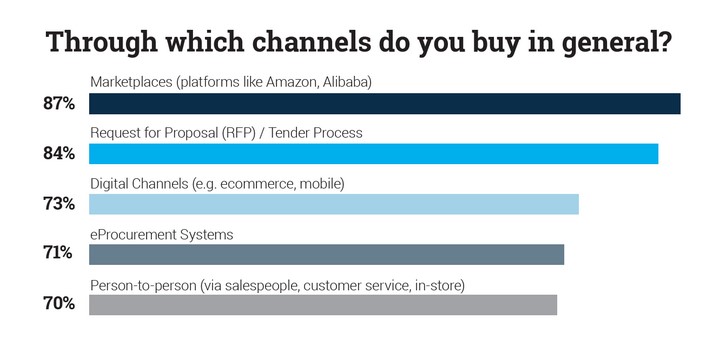When it comes to B2B vs D2C eCommerce, the gap in service is narrowing

Today’s B2B buyer is just as digitally savvy as their D2C counterpart — and they expect the same exceptional service.
The nature of today’s business-to-business (B2B) buyers and their expectations of working with suppliers and partners has changed. B2B suppliers are now expected to deliver the content, features and experiences that their buyers enjoy from their daily lives as D2C consumers.
For a B2B eCommerce strategy to be successful, it must take this reality into account.
B2B sellers aren't meeting modern buyer needs:
Research conducted by WBR Insights of 200+ business buyers across North America, Latin America, and Europe found that 87% of business buyers across all age ranges are making business purchases on online marketplaces.
- 87% of business buyers are purchasing on marketplaces [Amazon, Alibaba]
- 73% of respondents purchase in other digital channels [eComm + Mobile], while only 11% of respondents prefer these channels
- Only 8% of respondents prefer eProcurement systems for B2B purchasing

Why is B2B eCommerce more complex than D2C eCommerce?
B2B eCommerce tends to be more complex than D2C eCommerce; it involves heavier research, more needs-based purchasing, and less marketing-driven buying.
Many B2B buyers have very tight parameters around the purchases they can make, which means traditional revenue drivers like add-ons don’t typically offer the same impact. Historically speaking, B2B organizations didn’t have much of an incentive to optimize their customer journey -but this is changing in the current climate.
Here are a few reasons why B2B eCommerce is more complex than D2C:
- B2B buyers must consult with multiple departments before purchasing, while D2C consumers only have to consider themselves.
- B2B buyers look at the long term, which means they spend more time researching and sourcing recommendations, while the D2C customer is more prone to impulse buying or emotionally driven purchases.
- B2B buyers deal in high-value purchases, so any misstep is magnified. Small-value D2C purchasing errors are much less impactful.
- B2B buyers are generally repeat purchasers, so organizations have to consider the long-buyer lifecycle. D2C consumers will often only buy a product once.
- Since B2B buyers are making buying decisions for entire companies, they have a tighter remit than D2C customers.
Tips to improve your B2B eCommerce approach and provide a D2C-level experience
While B2B eCommerce may be more complex — and the needs of the buyer different – that doesn’t mean those buyers don’t expect the same level of service. Personalization has been a boon for D2C, but it can be for B2B as well.
Building personal relationships is crucial, especially during the buying cycle. According to the Salesforce State of the Connected Customer report, 72% of business buyers expect vendors to offer personalized engagement.
- A robust “My Account” page: The ‘My Account’ section includes accounting, profile management and order management. Some other features you can explore, depending on your ERP integration and eCommerce platform, are shopping lists, aging reports, credit applications, tax exemption, and much more.
- Multiple price lists: The B2C pricing model is almost always universal. All the customers purchasing a specific product are paying the same price. For B2B, complex pricing rules make for better wholesale management. Ideally, your store should be able to integrate such rules at every level of the product hierarchy.
- Catalog management tools: Another essential tool in B2B eCommerce is catalog management, which essentially includes restrictions on displaying a catalogue to specific users. Ideally, you should be able to set up individual groups, hide/show products depending on whether a user has signed up or not. Coupled with customized pricing, catalog management can make your operations even more granular.
- Corporate account management: Allowing new customers to sign up online and create their B2B account is critical. And since the B2C buyer is very different from the B2B buyer. B2B buyers aren’t singular buyers but instead purchasing parties who represent a company. Since the consequences of buying a low-quality product are high, the decision-making process is also complicated. With the right tools you can create a company profile for your buyers. Within that profile, not only can they conduct purchases as a single entity, they can also create a hierarchy closely simulating their physical roles within the organization they’re representing.
- Quick ordering: Giving your B2B buyers the ability to purchase products from a table (rather than going to each product page), or re-order based on previous orders is a must. Another option is to allow simply searching for a product through its name or serial number with an advanced site-search engine. These approaches help improve the B2B experience for frequent buyers by allowing faster purchases for customers
- Real-time inventory levels: Real time inventory updates will help your buyers and can help you in avoiding the risk of overselling and not having inventory for their orders.
- Payment options and quick check-out: Offering credit cards, purchase orders and payment terms in your check out is a must, but also ensuring your check out is optimized without slowing down the buying process (including registering for a new B2B account if the buyer doesn't already have one).
- Build a Quote funcitonality: Some key functionality to offer your B2B buyer is “request for quote”. With this functionality, buyers can quickly build a list of products and submit it to the store for quotation, potentially opening up negotiations with the user on the price of a particular set of products.
- ERP integration: An ERP system deals with complete business activities like purchasing, invoicing, supply chain, stock management, inventories etc.
- Mobile-first design: We highly recommend making your B2B eCommerce website mobile-centric. This will not only appease Google, where the algorithm changes consistently favor mobile-optimized websites, but will also make it much easier for customers to browse the catalogs and buy from whichever device they’re on. Research shows that 61% of buyers in the research phase are doing so with the help of a smartphone, so be ready for your buyers!
B2B organizations also need to make the most out of every opportunity to connect with their target audience, display a differentiator, and highlight their brand.
Here are a few easy ways that businesses can boost their B2B eCommerce experience:
-
Create an omnichannel experience
Today’s savvy consumer expects a seamless experience across touchpoints. The business buyer does as well, as 75% of buyers say that they expect vendors to have connected processes. In the same eBook, Transforming the B2B Sales Function, nearly 70% of buyers say that they now expect an “Amazon-like” experience. Creating an omnichannel experience is a win/win. It enables customers to engage on any channel and offers businesses a wealth of data to better understand their customers.
-
Offer 24/7 customer support
Since B2B deals with large orders and complex processes, it’s important to offer robust customer support at every stage of the journey. Consider implementing chatbots for 24-hour customer support. It’s also likely that the B2B buyer has already done some heavy research before approaching (another difference in B2B vs D2C), so consider creating an FAQ section that could answer questions.
-
Review the checkout process
While offering 24/7 customer support is important, it’s also important to give customers the opportunity to help themselves. According to a McKinsey report, 76% of B2B buyers find it helpful to speak to someone when they’re researching a product or service, but only 15% want to speak to someone when reordering. Offering one-click reordering, or even recurring subscriptions, can improve customer satisfaction.
-
Provide informative content
Since B2B eCommerce purchases aren’t as emotionally driven as D2C eCommerce purchases, it’s important to provide detailed information about products and services. Businesses can implement FAQs, community forums, video demonstrations, live chat, and more. Another difference in B2B vs D2C is that the B2B buyer will expect their salesperson to thoroughly understand their industry and be well-equipped to answer difficult questions.
What’s next for B2B eCommerce?
Today’s B2B buyers may have higher expectations, but that just means that B2B organizations must evolve to meet them. This is an opportunity for B2B companies to become more agile, responsive, and connected. And with a Forrester Report stating that 83% of B2B businesses expect to increase their eCommerce sales over the next three years, it’s also an opportunity to grow. When it comes to B2B vs D2C, the clear winner is the customer.
For more insights into the future of B2B eCommerce, get in touch with us to discuss your digital marketing strategy: